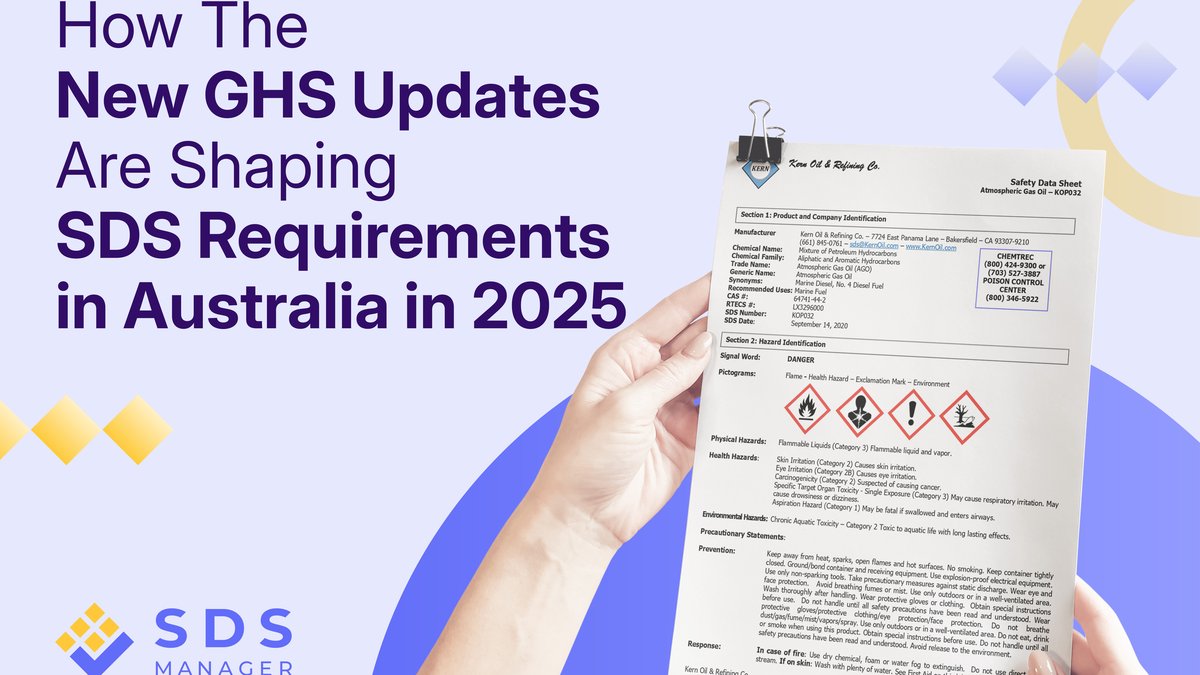

Australia’s approach to chemical safety is evolving, driven by recent updates to the Globally Harmonized System (GHS). As of 2025, these changes are significantly shaping the requirements for Safety Data Sheets (SDS), with direct implications for manufacturers, importers, and workplaces across the country.
Transition to GHS Revision 7
Australia completed its transition to GHS Revision 7 (GHS 7) at the start of 2023. From that point forward, all hazardous chemicals manufactured or imported into Australia must be classified, labelled, and accompanied by an SDS prepared in accordance with GHS 7 [see here]. This update replaced the previous use of GHS 3 and brought Australia’s chemical management in line with the latest international standards.
Key Changes Affecting SDS Requirements
- Mandatory Use of GHS 7: Only GHS 7 can be used for classifying chemicals and preparing SDS for newly manufactured and imported hazardous chemicals. This applies nationwide, with Western Australia’s start date slightly later (March 2023). [See here]
- Updated Precautionary Statements: The wording and structure of precautionary statements on SDS have been revised to match GHS 7, ensuring clearer communication of hazards and recommended safety measures.
- SDS Structure and Content: SDS must follow a strict 16-section format, covering identification, hazards, composition, first aid, firefighting, accidental release, handling, storage, exposure controls, physical and chemical properties, stability, toxicology, ecology, disposal, transport, regulatory information, and other relevant details. [See here]
- Australian-Specific Information: SDS must be written in English and include the name, address, and business phone number of the Australian manufacturer or importer, along with an Australian emergency contact number. Overseas SDS are not compliant unless they are updated with this local information.
- Review and Update Cycle: All SDS must be reviewed and updated at least every five years, with the last review date clearly stated. This ensures that the information remains accurate and up to date.
- Market-Specific Compliance: SDS are market-specific documents. Even if an SDS is GHS-compliant in another country, it must be updated to meet Australian requirements before use.
Exemptions and Special Cases
Certain hazardous chemicals are exempt from SDS requirements, such as chemicals in batteries within equipment, fuels in vehicle tanks, and some consumer products at retail premises. There are also provisions for simplified SDS for research chemicals, waste products, and samples for analysis when full information is not available.
Practical Implications for Businesses
- Immediate Compliance: All businesses that manufacture, import, supply, or use hazardous chemicals must ensure SDS are fully compliant with GHS 7 and Australian WHS regulations.
- Ongoing Responsibility: It is the duty of businesses to keep SDS up to date and ensure that workplace copies are current and reflect the latest regulatory changes.
- Accessibility: SDS can be managed both in paper or electronic form, but it should be easily and readily accessible when needed.
The adoption of GHS 7 has modernized Australia’s approach to chemical hazard communication, making SDS more informative, consistent, and aligned with global standards. As regulatory expectations continue to evolve, businesses must remain vigilant in reviewing and updating their SDS to maintain compliance and ensure workplace safety.
For a more detailed guidance, businesses should consult Safe Work Australia’s official resources and the model Code of Practice for the Preparation of Safety Data Sheets for Hazardous Chemicals.
How SDS Manager Can Help
Navigating these complex and dynamic SDS requirements demands robust SDS management solutions. SDS Manager offers a comprehensive platform designed to keep your chemical safety program aligned with the latest GHS standards.
Key Features That Help You Stay Compliant:
- Extensive safety data sheet Database & Import Tools: Access more than 16 million SDSs and easily import your chemical inventory to build a complete, up-to-date safety data sheet library.
- Automated safety data sheet Updates: Receive timely notifications for safety data sheet revisions and updates, ensuring your data reflects the latest hazard information.
- One-Click Access to Safety Information: Instantly access hazard details, PPE icons, first aid instructions, and spill precautions. Generate Safety Information Summaries for employee guidance.
- Secondary Container Label Generation: Create compliant labels in multiple sizes featuring QR codes, hazard codes, and PPE icons to meet labeling requirements.
- QR Code Integration & Mobile Access: Generate QR codes and posters for instant safety data sheet access on mobile devices, improving hazard communication and worker safety.
- Compliance Reporting: Generate detailed reports to stay audit-ready and demonstrate regulatory compliance effortlessly.
Getting Started Is Easy
Here's how you can take the next step toward streamlined chemical safety and compliance:
- Contact Us For Free Setup Support
- Uncover Features Designed With Your Challenges In Mind
- Book A 1:1 Consultation To Discuss Unique Compliance Needs
Take the First Step Toward Smarter SDS Management: Start Your Free Trial Today!